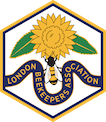
|
London Beekeepers' Association |

|
London Beekeepers' Association |
Planting on balconiesby Mark Patterson I'm often asked what can be planted at height to help bees. Here in the city, many of us live in high rise apartments or flats with little personal outdoor space. If were lucky we may have a small balcony or roof terrace and if very fortunate a garden. Even in a small confined space such as a balcony or small roof terrace it is possible to attract a large number of bees and other pollinating insects. Choose plants that do well in containers and can tolerate shallow growing conditions. Maritime and alpine plants will do well on high rise buildings as they have adaptations to cope with growing at altitude such as waxy, leathery or narrow leaves to avoid moisture loss through caused by winds blowing through them. Plants that are low growing and don't have long slender flower stalks will grow better at height than tall ones which may be blown over or snapped. Some examples of plants I grow on my balcony and window boxes on my 4th floor apartment include:
These represent but a few of the plants which will attract bees to a moderately high balcony or roof terrace providing it receives some sun for at least part of the day. If you live very high up then you will be less likely to be visited by bees which naturally forage not much higher then tree canopy height (you will however have a lovely display of flowers). Honey bees in particular, which use complex communications to inform their hive members where to locate the best forage have no way of communicating height in their waggle dances so are unlikely to visit very tall buildings to forage. When planting up your balcony or roof terrace choose the biggest containers you can comfortably fit in your space, safely move and transport. Rather than using pure soil or compost try mixing in Perlite with the compost or hydroponic expanded clay pebbles which will reduce the weight of the containers when full. You can also add moisture retaining gel crystals to reduce the frequency of watering and prevent plants from drying out. |
©2025 London Beekeepers' Association |